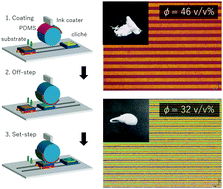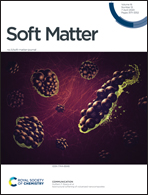Micro-transfer patterning of dense nanoparticle layers: roles of rheology, adhesion and fracture in transfer dynamics†
Abstract
Liquid inks deposited on substrates undergo spreading, coalescence, dewetting and subsequent drying kinetics, which limit the controllability of the cross-sectional shape and resolution of the printed patterns. By contrast, when the ink layers are previously semidried (highly-concentrated) and patterned on a polydimethylsiloxane sheet, single-micrometer features are resolved. Here we present the rheological, fracture and adhesive properties of semidried nanoparticle dispersion ink layers, which optimize the patterning of reverse offset printing with 5 μm spatial resolution. Under the appropriate patterning conditions, when the volume fraction ϕ of the particles in the semidried layers was approximately 46 v/v%, the layer elasticity was dominant in the linear viscoelastic region and a Burgers-type creeping property appeared. Under tensile strain, the semidried layers suddenly fractured at the sites of patterns with sharply defined sidewalls. In the semidried thin layers dominated by viscosity (lower ϕ), the pattern edges were degraded owing to local transfer instability and possible subsequent spreading. Over-drying reduced the adhesiveness of the ink layers, implying an upper limit of ϕ for successful patterning. The characteristics of semidried inks contribute to establishing a versatile ink-formulation scheme of various functional nanomaterials for high-resolution printed applications.



 Please wait while we load your content...
Please wait while we load your content...